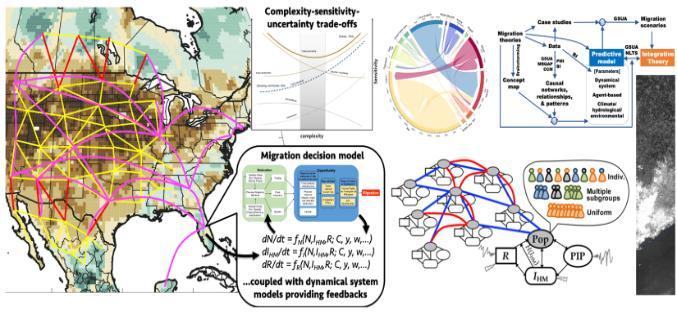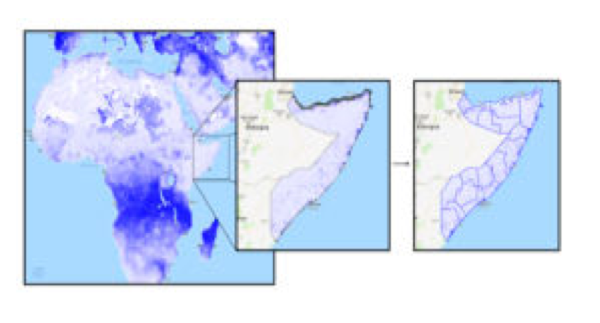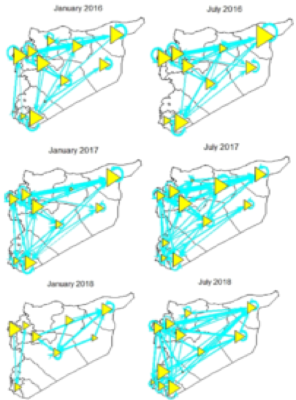Our Work
Publications
Muneepeerakul, R., & Anderies, J. M. (2020). The emergence and resilience of self-organized governance in coupled infrastructure systems. Proceedings of the National Academy of Sciences, 117(9), 4617-4622. (Download PDF)
Jägermeyr, J. et al., including Puma, M. J. and Heslin, A. (2020). A regional nuclear conflict would compromise global food security. Proceedings of the National Academy of Sciences, 117(13), 7071-7081. (Download PDF)
Kinnunen, P., Guillaume, J. H., Taka, M., D’Odorico, P., Siebert, S., Puma, M. J., Jalava, M. & Kummu, M. (2020). Local food crop production can fulfil demand for less than one-third of the population. Nature Food, 1(4), 229-237. (See Publication)
Heslin, A., Puma, M. J., Marchand, P., Carr, J. A., Dell'Angelo, J., D'Odorico, P., ... & Seekell, D. A. (2020). Simulating the cascading effects of an extreme agricultural production shock: global implications of a contemporary US Dust Bowl event. Frontiers in Sustainable Food Systems, 4, 26. (See Publication)
Schon, J. (2020). How Seasonal Migration May Reduce Security Threats from Climate-Induced Migration. Strategic Multilayer Assessment. (Download PDF)
Heslin, A., & Thalheimer, L. (2020). The Picture from Above: Using Satellite Imagery to Overcome Methodological Challenges in Studying Environmental Displacement. Oxford Monitor of Forced Migration, 75.
Oh, W. S., & Muneepeerakul, R. (2019). How do substitutability and effort asymmetry change resource management in coupled natural-human systems? Palgrave Communications, 5(1), 1-8. (See Publication)
Homayounfar, M., Muneepeerakul, R., Anderies, J. M., & Muneepeerakul, C. P. (2018). Linking resilience and robustness and uncovering their trade-offs in coupled infrastructure systems. Earth System Dynamics, 9(4). (See Publication)
MURI-Related Blog Posts
Puma, M. "Where Will Future Migrants Come From?" State of the Planet. August 21, 2018.
Muneepeerakul, R. "What's The Deal With Human Migration?" UF ABE Blog Post. July 24, 2018.
MURI Work-In-Progress
Dynamical and agent-based models of migration and environmental changes
We are developing dynamical, stochastic models to couple the dynamics of migration and environmental variables, aiming at capturing the effects of environmental changes on migration and vice versa. Such feedback loops have not been systematically incorporated in migration models. Relatively simple dynamical models lend support to clear insights on potential tipping points hidden in this complex system. Different locations are linked by multiple types of relationships (depicted by different colors) and will drive migration in different ways. These models will serve as benchmarks and theoretical underpinning of more detailed agent-based models (ABMs) that will be designed to investigate the effects of heterogeneities among individuals and migration patterns that may emerge from them. Such an ABM is being developed and analyzed: we try to keep things simple, learn as much as we can from the factors currently included, before we add more realistic and more complex factors.

Migration Tipping Points
Heslin, Alison. "Using Satellite Imagery and Geographic Data to Understand Climate-Induced Displacement." Science for Decision-Making in a Warmer World: 10 Years of the NPCC New York Academy of Sciences, New York, NY. March 15, 2019.
Understanding drivers of forced migration requires detailed information on the context, timing, and location population movements. While data is critical to this understanding, the context of displacement, such as natural disasters or conflict, can disrupt official data collection. In such contexts, intermittent ground-level data can be supplemented with spatially and temporally high-resolution satellite data including satellite imagery and radar data. To supplement official data in our case study countries, we are using satellite imagery to generate near real-time data on environmental forcings and population movements.

Justin Schon and Adam Lichtenheld. The Consequences of Internal Displacement on Syrian Conflict Dynamics. Presented at International Studies Association Annual Meeting 2019.
Abstract: The number of people displaced by armed conflicts worldwide has reached levels not seen since World War II, posing significant global security challenges. While a growing body of research examines the transnational impacts of refugee flows, there have been few studies of the consequences of displacement within a country's borders. This is important since modern civil wars create far more internally displaced persons (IDPs) than refugees. In this paper, we focus on how armed groups respond to displacement flows, which we argue is essential for understanding the impact of forced population movements on violence and broader conflict dynamics. Drawing on both quantitative and qualitative data on the Syrian civil war, we argue that this impact is a product of how warring parties manage network patterns of IDP flows, not just inflows and outflows. Different armed actors respond to IDP flows in different ways, which is shaped by the incentives, priorities, and constraints that each one faces in civil wars. These responses can be differentiated by four different logics: COIN, rebel governance, ethnic governance, and Islamic governance. These approaches are essential for helping explain the link between displacement and violence, and the location and level of violence following IDP flows.

NOTE: Larger triangles indicate more civilian fatalities. Line width indicates logged magnitude of the IDP flows.
Multi-Layer Network Analysis of Refugee Flows
Visualizing refugee flows (Jeffery C. Johnson, Justin Schon, and Elise Geissler)
Our team has examined many options to visualize global refugee flows as a dynamic network. For this work, we have found the ndtv package in R to be especially useful. Clearly visualizing refugee flow data is an important step in allowing us to accurately identify trends in refugee flows and opportunities for analysis.
MR-QAP analysis of refugee flows (Jeffery C. Johnson and Justin Schon)
Our work recognizes that refugee flows are one type of relationship between countries. To analyze the causes and effects of refugee flows, we see a need to account for inter-dependencies between countries. Standard dyadic regressions that assume independence between observations are unable to do this. While Exponential Random Graph Models (ERGMs) have many benefits in this regard, they are unable to incorporate multiple types of relationships into their analyses. Therefore, we are using the quadratic assignment procedure to examine refugee flows and a wide range of other relationship characteristics between countries.
